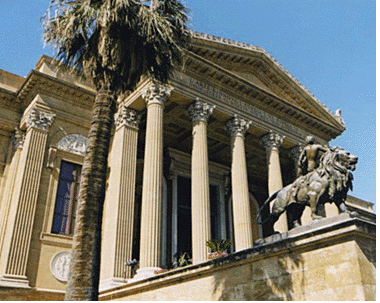...Best of Sicily presents... Best of Sicily Magazine. ... Dedicated to Sicilian art, culture, history, people, places and all things Sicilian. |
by Carlo Trabia | ||
Magazine Index Best of Sicily Arts & Culture Fashion Food & Wine History & Society About Us Travel Faqs Contact Map of Sicily |
It has been suggested that the rediscovery of the Roman structures at Pompeii and Herculaneum inspired the movement. They certainly influenced it later. Neoclassical civil structures and churches abound in Italy, but they were first popularised in Paris and then London. Only in the early years of the nineteenth century, perhaps under Napoleonic influence, did Italy truly embrace the Baroque. One of the most prominent examples was the church of San Francesco di Paola, across a large square from the royal palace in Naples. Its design was based on Rome's Pantheon. Often, churches and palaces which were classical on the outside had Baroque interiors. In more bizarre cases, the Neoclassical and Baroque were actually combined! Munich, Saint Petersburg and Washington soon became bastions of Neoclassical architecture. In Sicily, Palermo was its focus. The Teatro Massimo opera house (shown here) was designed by Giovanni Battista Basile, better known for his Art Nouveau buildings. Construction was begun in 1874 but completed only in 1897. The Massimo was then the largest opera house complex in Europe (though the hall, or auditorium, of La Scala is about the same size). This opera house is distinguished for its Greek (rather than Roman) exterior style, inspired by the temples at Agrigento. Palermo's Politeama opera house is another fine example of Neoclassical architecture. This was built to designs by Damiani Almejda between 1867 and 1874 based on the influence of the buildings at Pompeii. But as soon as it was opened the city of Palermo began building the much larger Massimo. Critics have often remarked that both these costly building projects were undertaken at a time when the city lacked a public hospital. The Neoclassical is not a difficult style to appreciate. It was part of an age when great public works were supposed to be a reflection of great societies, great nations or great faiths. The Gothic was impressive but in Sicily it rarely existed in a very "pure" form. In Sicily, it was not so much an evolution as a substitute for the ornate lines of the Sicilian Baroque, and part of an effort to introduce in civil structures a grandiose impression previously reserved primarily for ecclesiastical ones. About the Author: Architect Carlo Trabia has written for this publication and others. | |
Top of Page |
 The architectural movement we now call
"Neoclassical" developed in the mid-1700s, largely as a reaction
to the Baroque style. British, French and German forms soon evolved. What
they bore in common was a quest for purity of line reminiscent of ancient
Roman and Greek structures. In some ways the Neoclassical sought to recapture
something of the early Renaissance as well.
The architectural movement we now call
"Neoclassical" developed in the mid-1700s, largely as a reaction
to the Baroque style. British, French and German forms soon evolved. What
they bore in common was a quest for purity of line reminiscent of ancient
Roman and Greek structures. In some ways the Neoclassical sought to recapture
something of the early Renaissance as well.